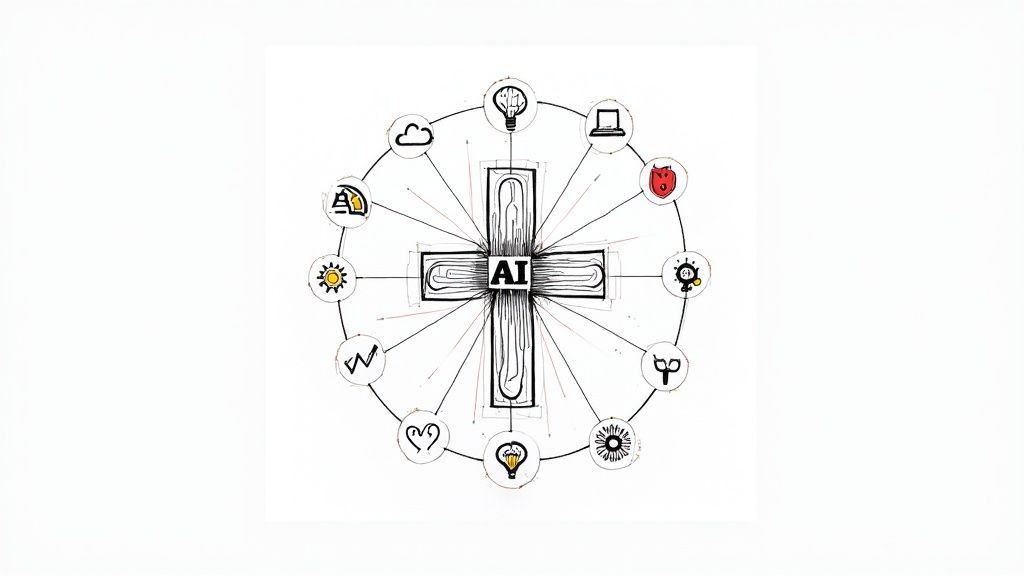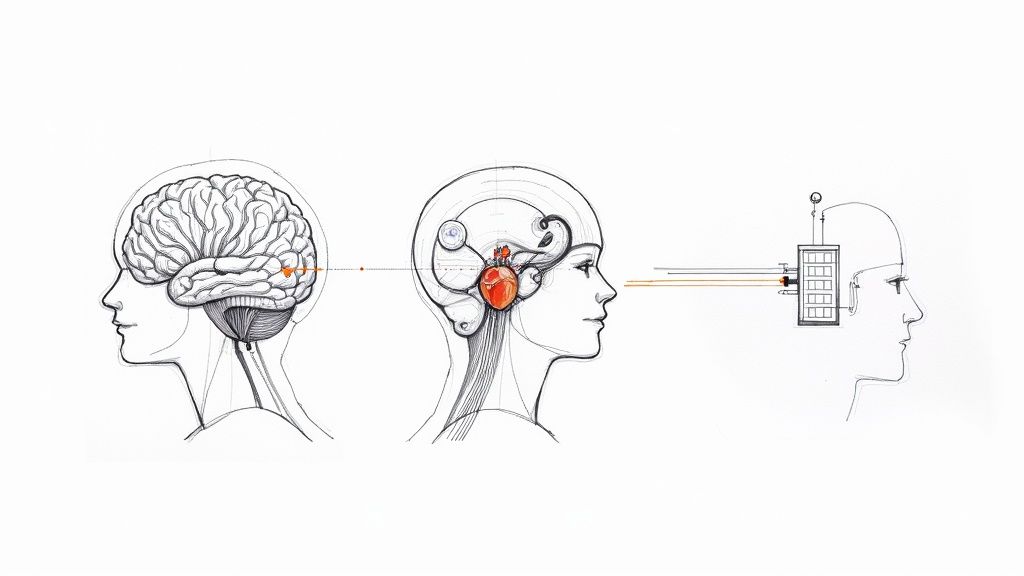Build MVP with AI Consulting Support: Your Quick Guide
Learn how to build MVP with AI consulting support. Discover proven strategies to validate, develop, and scale your AI project effectively.

Building an AI-powered Minimum Viable Product (MVP) isn't just about writing code. It's a whole different ball game. It requires a deep understanding of complex data, predictive models, and an architecture that won't buckle under future demands. This is where bringing in AI consultants from the start can be a game-changer. They provide the experience needed to sidestep common pitfalls and make sure your project is built on solid ground.
Think of it as the difference between a promising idea and a market-ready reality.
Why Expert AI Consulting Is Key to Your MVP
Jumping into an AI project without someone who's been there before is a huge risk. Unlike standard software, AI MVPs have unique failure points that can sink even the most brilliant concepts before a single user sees them. A lot of companies hit this wall; research consistently shows that trying to build without a clear, expert-informed plan is a top reason AI projects fail to get off the ground.
This is exactly why dedicated AI strategy consulting is so valuable. A good partner doesn't just build what you ask them to. They push back. They challenge your assumptions, help you sharpen your vision, and make sure the problem you’re solving is one where AI actually provides a real, measurable advantage. It completely changes the dynamic from a "build it and see what happens" gamble to a strategic project built on practical feasibility.
Avoiding Common and Costly Traps

One of the most important jobs of an AI consultant is to be your strategic safety net. They're there to help you avoid the critical mistakes that often blow up budgets or kill projects entirely.
Here are a few of the big ones they help you sidestep:
Solving the Wrong Problem: It's easy to get excited about what AI can do. Consultants help validate that your use case is not only technically possible but also solves a real, high-value problem for your users.
Piling Up Technical Debt: They guide you on choosing the right tech stack and models from the start. This prevents you from picking a flashy but ill-suited algorithm that you'll have to tear out and replace later at a massive cost.
Letting Scope Creep Derail Progress: An experienced partner is ruthless about enforcing the "minimum" in MVP. They keep the team laser-focused on the core features needed to test your main hypothesis, nothing more.
This kind of expert guidance is becoming more critical by the day. The market for AI consulting services is expected to explode from roughly USD 11.07 billion in 2025 to an incredible USD 90.99 billion by 2035. You can learn more about the AI consulting market's rapid growth and the reasons behind this surge. It’s a direct reflection of how complex these projects are becoming.
By bringing in consultants early on, you create a clear AI strategy framework that connects your technical work directly to your business goals. That proactive alignment is often what separates a stalled prototype from a successful product launch.
Ultimately, when you build an MVP with AI consulting support, you’re buying down risk. You're not just hiring coders; you're gaining a partner with a wealth of experience in everything from messy data to tricky model limitations, ensuring every decision you make is an informed one.
Standard MVP vs AI-Powered MVP Development
Building an AI MVP introduces a layer of complexity that you just don't see in traditional software development. The table below breaks down some of the key differences and shows where expert guidance becomes absolutely essential.
Development Phase | Standard Software MVP | AI-Powered MVP (with Consulting Support) |
|---|---|---|
Problem & Scope | Focus on user stories and core features. | Focus on data viability and model potential. Consultants validate the AI use case. |
Data Requirements | Standard user data and application state. | Requires large, high-quality, labeled datasets. Consultants define data acquisition and prep. |
Core Technology | Selecting a well-known web or mobile framework. | Involves model selection, training, and validation. Consultants help choose the right algorithms. |
Testing & Validation | Functional testing and user acceptance testing (UAT). | Includes model performance metrics (accuracy, precision). Consultants design robust evaluation plans. |
Iteration & Feedback | Improving features based on user feedback. | Involves model retraining and fine-tuning. Consultants guide the MLOps and iteration cycle. |
As you can see, the AI-powered path involves a lot more specialized, upfront work. Having a consultant to guide these critical early decisions is what sets the project up for long-term success instead of a quick flameout.
Crafting Your AI Strategy and Vision
Before you even think about writing code, you need a solid game plan. This is where most AI projects stumble. It’s not about dreaming up flashy features; it's about grounding your big idea in reality and pinpointing a specific, high-value business problem that AI can genuinely solve better than anything else you're doing now. A surprising 43% of companies admit that a lack of clear strategy is their biggest roadblock to getting AI off the ground.
So, where do you begin? Start by getting brutally honest about the user's pain point. "We want an AI to improve customer service" is far too vague. A much stronger vision is, "We need to slash our response times for common support tickets by 50% without adding headcount." See the difference? That kind of clarity is gold. This is where bringing in expert AI strategy consulting early on can save you a world of hurt, helping you confirm that AI is actually the right tool for the job and not just a fancy, over-engineered solution.
From a Vague Idea to a Tangible Plan
Once you've zeroed in on the problem, you need to define what winning actually looks like. This means getting past fuzzy goals and setting concrete, measurable metrics. These numbers will be your North Star, guiding every decision you make and ensuring you're always focused on delivering real business results.
From the get-go, you should be tracking two types of metrics:
Technical Metrics: How well does the AI actually work? This could be something like achieving 90% accuracy in spotting fraudulent transactions or ensuring product recommendations load in under 500ms.
Business Metrics: How does the AI impact the bottom line? Think in terms of a 15% jump in user adoption in the first three months, a 20% cut in operational costs, or a 10% lift in your conversion rate.
I’ve seen this mistake derail projects time and time again: building an MVP without this dual focus. You can have a technically flawless model that's a complete business failure because it doesn't move a single important metric. Aligning these technical and business goals is the whole point of a strong AI strategy framework.
Conducting an Initial Feasibility Check
With a clear problem and success metrics in hand, it's time for a reality check. An experienced consultant is invaluable here, helping you ask the tough questions that de-risk the project before you sink serious time and money into it.
You absolutely must address these key feasibility questions:
Data Availability: Do we actually have enough clean, relevant data to train a decent first model? If not, what's our plan to get it?
Technical Complexity: Are we talking about a straightforward, well-understood AI model, or does our idea require brand-new research that could blow up our timeline?
Resource Allocation: Does our in-house team have the chops for this? Or do we need to bring in partners, like our expert team, to fill critical skill gaps?
This early due diligence is what separates the successful AI MVPs from the science projects. It ensures you build an MVP with AI consulting support that's not just ambitious but, more importantly, achievable. This is how you set yourself up to deliver real value, right from the start.
Defining Your MVP Scope for Maximum Impact
You've got the big-picture strategy. Now comes the hard part: translating that vision into a tangible development blueprint. This is where we get laser-focused on the "Minimum" and "Viable" parts of your AI MVP, a process that demands some ruthless prioritization.
The goal here is simple: avoid the all-too-common trap of overbuilding. It’s a classic mistake that burns through your budget and, worse, delays the vital market feedback you need to see if you're even on the right track.
A truly effective MVP hones in on the one critical function that tests your core idea. For example, instead of trying to build a massive, AI-driven search engine for your e-commerce site, your MVP might just focus on one thing: generating personalized product recommendations for the homepage. This stripped-down approach lets you validate the core concept fast. A good consulting partner helps you maintain this discipline, often using an AI requirements analysis to sift through the "must-haves" and shelve the "nice-to-haves."
This kind of methodical planning is everything. In the US market, IT consulting accounts for a staggering 53.4% of all AI consulting revenue. This is driven by companies needing exactly this type of strategic planning and system integration support. You can discover more insights about AI consulting market trends to see just how foundational this stage really is.
Creating a Lean and Focused Feature Set
To keep your MVP lean, every single feature has to fight for its spot. The trick is to work backward from your main success metric.
Let's say your goal is to slash the number of customer support tickets. Your core MVP feature, then, might be an AI chatbot that can confidently answer the five most common questions. Anything else is just noise.
This is where an experienced AI consultant proves their worth. They can run workshops with your team to:
Pinpoint the Core User Journey: What's the single most important path a user takes to get value from your AI? Let's map that out.
Prioritize One Key Function: We'll force-rank all potential features and pick the one that directly tests your biggest assumption.
Define the Data Needs: What's the absolute minimum data required to train the first model? No more, no less.
Set Realistic Goals: We need clear, achievable performance targets for the MVP, like hitting 70% accuracy for the initial model.
Following this process helps you build an MVP with AI consulting support that is fast, focused, and built for one thing: learning. This flow from defining what you need to seeing the return is what it's all about.
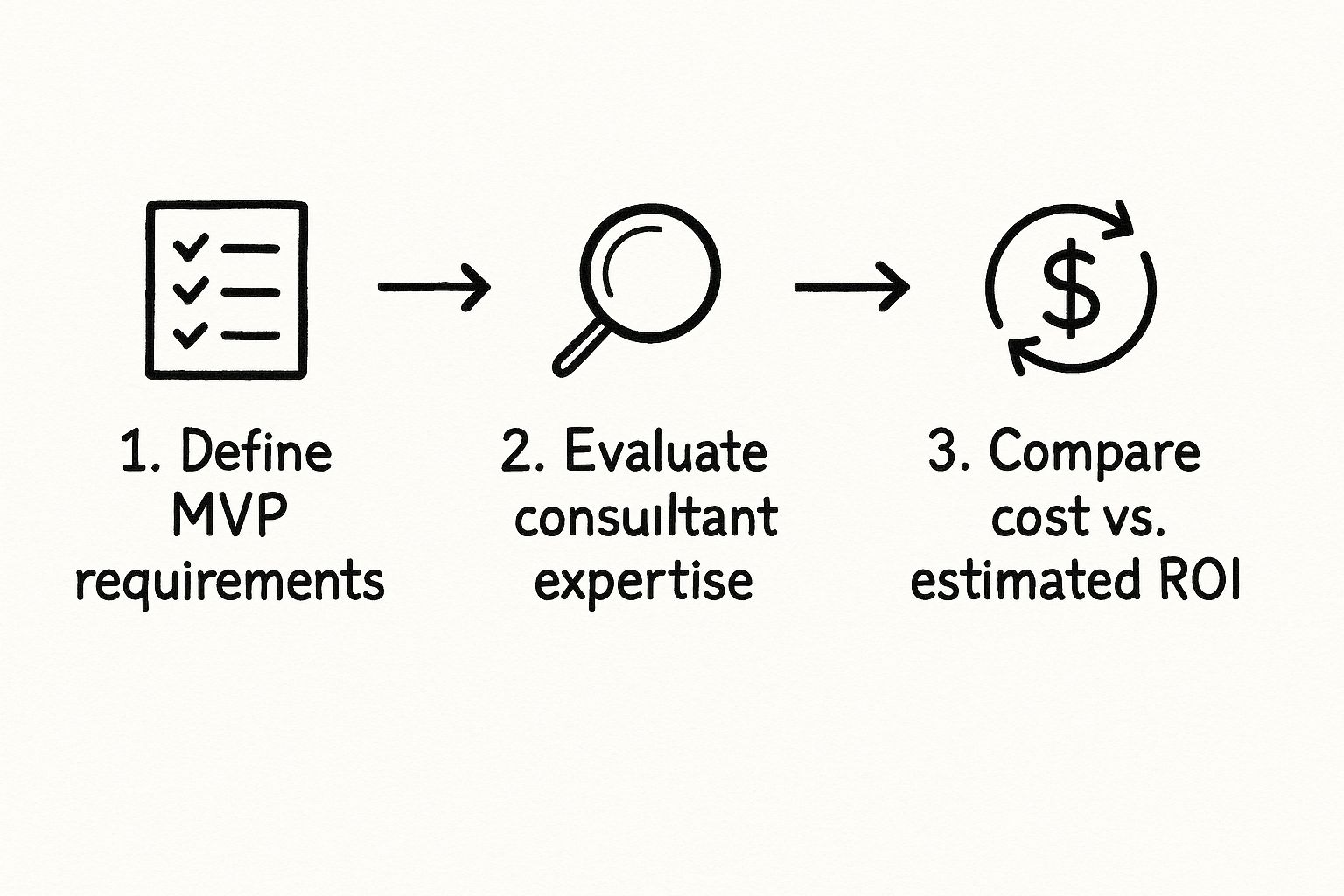
As this graphic shows, a great AI MVP is born from clear requirements, guided by the right expertise, and justified by a solid business case. We've seen it time and again. As we explored in our AI adoption guide, looking at real-world use cases can be a huge source of inspiration for scoping projects to get the biggest bang for your buck.
Building Your AI MVP Through Co-Creation
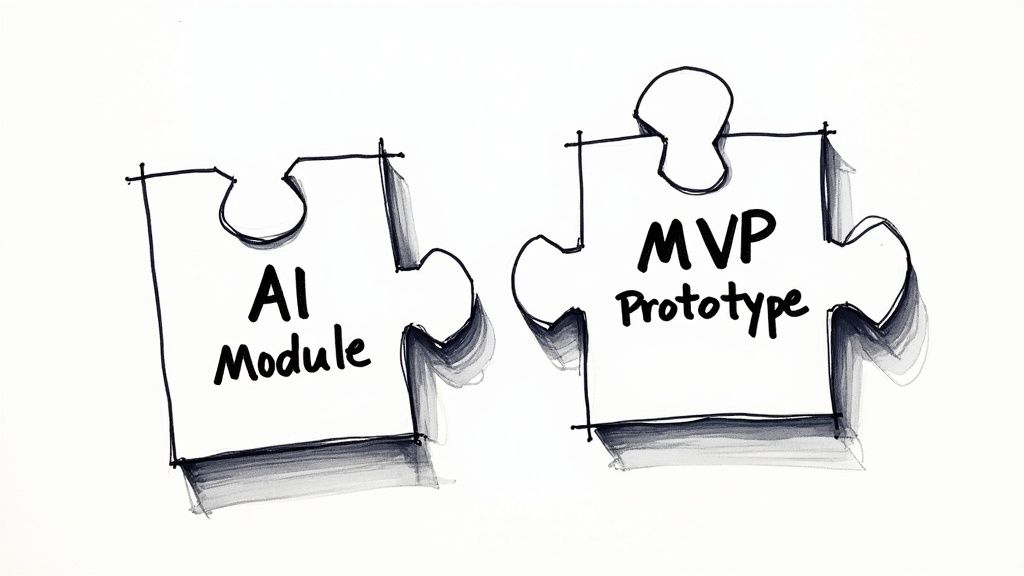
Alright, you’ve defined a lean scope. Now the real fun begins: the development phase. But let's be clear, this isn't a traditional hand-off where you send a check and hope for the best. To successfully build an MVP with AI consulting support, you need to think of it as a deep, collaborative partnership.
We call this an AI co creation journey. Your team and the expert consultants work side-by-side in quick, focused development cycles known as agile sprints.
This partnership approach is critical because building an AI product is nothing like building a standard website. There's no static blueprint to follow. It’s a process of constant experimentation, learning, and fine-tuning based on how the model performs with real data. The market is screaming for this kind of collaboration, with the global AI consulting services market expected to jump from USD 22.27 billion in 2025 to a massive USD 257.60 billion by 2033. This isn't just about getting an AI model deployed; it's about having a strategic partner for the tough stuff like data engineering, model customization, and execution.
The Agile Sprints of AI Development
The entire co-creation process lives and breathes in these agile development sprints. Think of each sprint as a mini-project with its own tangible goal. This structure keeps momentum high and, more importantly, allows the team to learn and pivot quickly.
Each development cycle usually breaks down into a few key stages:
Data Collection & Preprocessing: Honestly, this is where a lot of the unglamorous but essential work happens. Your consultants will guide your team on gathering the right data, cleaning it up, and structuring it so a model can actually learn from it.
Model Training & Evaluation: Here, the first version of the AI model is built and trained using that prepared data. We then put it through its paces, testing it against the success metrics you defined earlier to see how it holds up.
User Interface Integration: An AI model is useless if no one can interact with it. This stage involves hooking the model up to a user-facing front end. This is where the "viable" in MVP truly comes to life.
Feedback & Refinement: Your internal team and key stakeholders get their hands on the early product. Their feedback is gold, and it directly shapes what gets built or fixed in the next sprint. This continuous loop is what makes the AI smarter over time.
Managing all these moving parts requires crystal-clear communication. This is where a shared platform, like an AI Strategy consulting tool, becomes invaluable. It serves as the single source of truth for tracking progress and keeping everyone aligned.
What to Expect from Your Consulting Partner
Throughout this journey, a good consulting partner plays multiple roles. They aren't just coders; they are mentors, strategists, and project managers rolled into one. You should expect regular check-ins, completely transparent progress reports, and a big focus on knowledge transfer. The goal is to build your team’s internal AI skills, not to create a long-term dependency.
We believe the aim is to empower your organization. To see how this partnership works in practice, our guide on AI implementation support breaks down how we help teams translate their strategy into a functioning product. This collaborative spirit ensures the final MVP isn't just a technical novelty but a powerful solution that’s truly woven into your business.
Evaluating Your MVP and Planning for Scale
So, you’ve launched your AI MVP. Congratulations. But don't pop the champagne just yet—this is the starting line, not the finish. Now, the real fun begins. You're about to find out if your big idea actually works in the wild by gathering real-world data and seeing if your initial hypothesis holds up.
This is where the project shifts from building to learning. You're using cold, hard evidence to decide what to do next. To get this right, you need to track two things simultaneously: how the tech is performing and how it's impacting your business. It’s a balancing act that ensures your shiny new AI is not just technically sound, but actually creating value. This is often where having ongoing AI strategy consulting makes a world of difference, as experts can help you translate raw numbers into a clear, strategic direction.
Balancing Technical and Business Metrics
Your success isn't just about one set of numbers; it's a mix of two equally critical categories. You've got the technical metrics on one hand, telling you if the model is doing its job correctly. On the other hand, you have the business metrics, which tell you if your users and your bottom line are even noticing.
Technical Metrics: Think of these as the engine's vitals. We're talking about core performance indicators like model accuracy, latency (how fast it gives you an answer), and error rates. For instance, is that new recommendation engine actually hitting the 85% accuracy target you aimed for during development?
Business Metrics: This is where the rubber meets the road. These numbers measure the tangible impact on your organization—things like user engagement, conversion rates, and cost savings. Did launching that AI-powered feature result in a 10% jump in daily active users like you hoped?
A truly successful MVP will show strong signals in both areas. You can have the most technically brilliant model in the world, but if it doesn't move a single business needle, it’s just a very expensive science project. This is precisely why a seasoned partner is invaluable; they keep the focus squarely on the outcomes that actually matter to your business.
The whole point of this exercise is to use the initial feedback to create a roadmap that's backed by data, not just gut feelings. Every metric, good or bad, is a lesson that will shape your next sprint, feature, or model update.
To make this process clearer, here's a breakdown of the key metrics you should be tracking to evaluate your AI MVP's performance. These will give you a comprehensive view, covering everything from the model's raw performance to its real-world business impact.
Metric Category | Example Metric | What It Measures |
|---|---|---|
Model Performance | Accuracy / Precision / Recall | The fundamental correctness of the AI's outputs and predictions. |
Operational Health | Latency / Uptime | The speed and reliability of the AI system in a live environment. |
User Engagement | Daily Active Users (DAU) / Stickiness | How often and consistently users are interacting with the AI feature. |
Business Impact | Conversion Rate / Churn Reduction | The direct effect of the AI on key business goals and revenue. |
Cost Efficiency | Cost Per Prediction / Inference | The operational cost to run the AI, ensuring it's financially sustainable. |
Keeping a close eye on these categories gives you the full story. It helps you avoid celebrating a technical win that doesn't translate to business success, and it grounds your future plans in reality.
Turning Insights into a Data-Driven Roadmap
After you’ve collected a few weeks of solid data, it’s time to huddle with your consultants and figure out what’s next. This is the moment you turn a spreadsheet full of numbers into a clear, actionable strategy for evolving your product. Using a collaborative platform like an AI Strategy consulting tool is a great way to keep everyone aligned and the entire process transparent.
Your roadmap discussions should really zero in on three key questions:
What’s the next most valuable feature? User feedback and engagement data should be your guide here. Let the numbers—not your assumptions—dictate what you build next.
When do we retrain the model? AI models can "drift" over time as they encounter new data, causing performance to dip. Your roadmap needs to include regular retraining cycles to keep the model sharp and effective.
How do we prepare for scale? If the MVP is a hit, you need a solid plan to grow the infrastructure. This means thinking about how you'll move from a lean, minimal setup to a robust architecture ready for a flood of new users and data.
This cycle—measure, learn, plan, repeat—is the very essence of how you build an MVP with AI consulting support and grow it into a truly powerful, market-leading product. If you're ready to navigate this critical post-launch phase, connect with our expert team to see how we help companies turn their MVP momentum into long-term success.
Your Path to a Market-Ready AI Product
We've just walked through the entire journey of taking an AI MVP from a high-level concept to a product that actually delivers value. It’s a path that begins with a solid AI strategy framework and a laser-focused, lean scope.
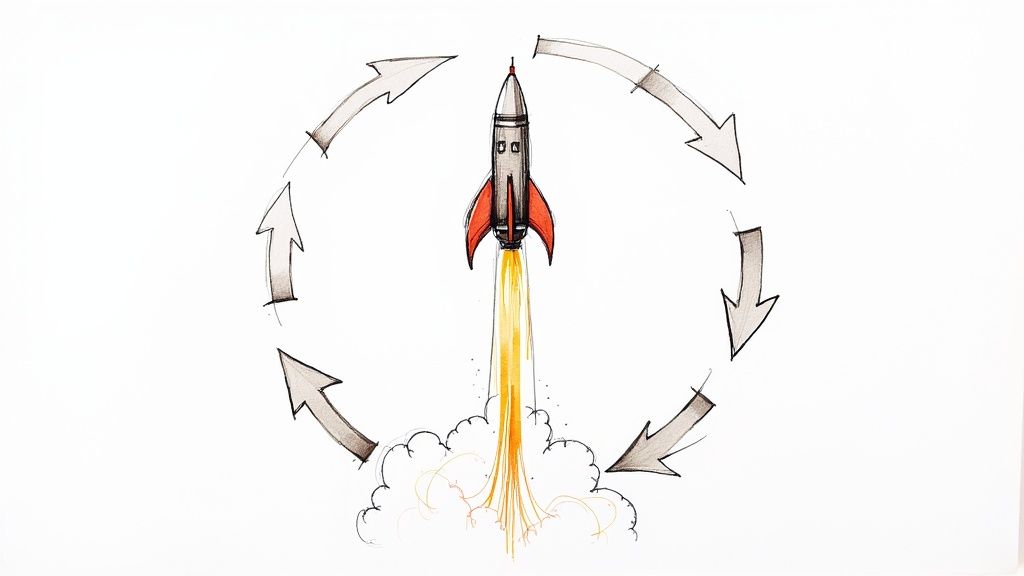
From there, the real work begins with a hands-on AI co creation process, where agile methods and constant, clear communication are non-negotiable. Finally, you prove it works by measuring what really matters—not just technical metrics, but tangible business impact. This structured approach is everything, especially when you remember that a shaky or nonexistent strategy is one of the biggest reasons AI initiatives fail.
The key takeaway is that with the right approach and partnership, you can confidently navigate the complexities of AI development. This transforms your vision from a mere idea into an impactful, market-ready product that solves a real problem.
This entire process, from the initial AI requirements analysis to digging into real-world use cases, is all about de-risking your launch. As we’ve seen, a well-planned MVP is your fastest path to learning what works in the real world.
Ready to take the next step? Connect with our expert team to talk through your project and see how the right support can get you to market faster.
Frequently Asked Questions
It's completely normal to have questions when you're diving into an AI MVP. Let's tackle some of the most common ones we hear from founders and product leaders.
How Much Does It Cost To Build An AI MVP With Consultants?
This is the big one, and the honest answer is: it depends. The final price tag for an AI MVP is shaped by its complexity, the state of your data, and the overall project scope. A good consulting engagement isn't about charging for hours; it's about maximizing your investment and reducing risk right from the start.
That's why we always begin with an initial consultation. This helps us build out an AI strategy framework and define a crystal-clear scope, which in turn gives you a reliable budget and a solid estimate of the investment required.
How Long Does It Take To Develop An AI MVP?
For most AI MVPs, you can expect a development timeline of three to six months. This isn't a hard-and-fast rule, of course. The schedule can shift based on things like how quickly we can access your data, how intricate the AI model needs to be, and the final list of features.
The initial AI requirements analysis is absolutely critical here. Nailing this phase down sets a realistic timeline and helps us sidestep those unexpected delays that can throw a project off course.
I've seen it time and time again: teams wildly underestimate the data preparation stage. Cleaning, labeling, and structuring your data to be model-ready can easily take up as much time as building the model itself, if not more.
What Is The Difference Between AI Consulting And Hiring Freelancers?
Think of it as the difference between hiring a specialist and hiring a strategic partner. An AI consultant offers an end-to-end partnership that goes far beyond just writing code. We're with you from the initial idea and feasibility study, through the complex data engineering and model selection, all the way to planning how you'll scale the product post-launch.
This holistic approach, which we call AI co creation, is designed to prevent the kind of expensive strategic mistakes that can sink a project. It ensures the product we build together is fundamentally tied to your most important business objectives—a much broader mission than what you'd typically get from a freelancer.
Have more questions? We've got more answers. Feel free to dig into our comprehensive FAQ page.
Ready to transform your AI concept into a real, market-ready product? The Ekipa AI team is here to guide you through every step. Connect with our expert team to chat about your project and see how our hands-on support can get you to launch faster.


